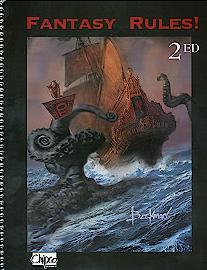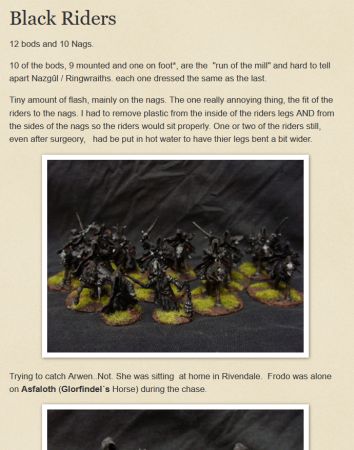
Total Votes: 10
Description
Battle rules for fantasy miniatures, designed for play in 1-2 hours.
Players use a point system to construct an army, either using one of over 50 pre-generated army lists or inventing a custom force. The army lists note which unit and character types are available to an army, and note how many elites are allowed per army. Armies are composed of units (large bodies of troops) and characters (individuals). Unit types are infantry, cavalry, monsters, war machines, and Specials ("powerful outer planar entities"), with each type including one or more sub-types. (For instance, the Infantry type includes beastmen, crossbows, fanatics, handguns, handweapons, longbows, mobs, offerings, pavisiers, pikes, rangers, skirmishers, and spears.) Characters are either Major or Minor. Major characters can "lead" units, and affect morale when lost. Generals (one per army), bards, heroes, assassins, necromancers, clerics, shamen and wizards are examples of characters. Based on an army's size, there are limits to how many powerful characters an army is allowed. Special items and abilities can be purchased for units and characters.

Central to play is the concept of the morale clock, a rating which each army possesses. In any phase in which one player's losses exceed those of his opponent, his Morale Clock score is lowered. The loss of Major Characters also reduces the clock. As the clock winds down, so does the army's ability to move and cast spells.
Fantasy Rules! is played in turns, each consisting of alternating player-phases. Each player-phase is composed of several steps or sub-phases (rally, ranged fire, movement, challenge combat, melee combat, follow-up movement). An army's Morale Clock determines how many units may move. However, Generals and Major Characters allow a player to move additional units, and units can be more easily moved when formed into Groups. Combat is resolved on a unit vs unit basis, resulting in destruction or demoralization. Units which are "double demoralized" suffer additional penalties, while those which receive a third demoralization result are eliminated from play. Demoralizations are removed by a successful rally attempt.
At the start of each turn (not phase), both players roll dice to determine their Magic Points. Separate rolls are made for each magic-user, with those points going into his "pool"; there is also an "army pool" which can be shared among all magic-users. If an army's Morale Clock is below a certain threshold, their magic dierolls are reduced. Spells can be cast at any time, if the magic-user can pay sufficient points for that spell (half of the cost must come from his own pool). The spell is automatically successful unless the opposing army spends Magic Points to dispell it, in which case dice are rolled to determine the result. There are 10 types of spellcaster (wizard, cleric, shaman, necromancer, hive queen, and ship's cook, plus sub-types), each with between 3-6 spells available to them.

Characters generally attach themselves to units, both for safety and to use their special abilities. When units with atached characters fight, one character can challenge the other to "challenge combat" (a duel). When a unit is eliminated, a dieroll determines whether characters die, flee, or are captured.
The game ends when one army has been eliminated, or when one side's Morale Clock strikes 0. The winner is then determined on a points basis.
Additional or optional rules cover over-size and overly-powerful units (juggernauts), fortifications, bodyguards, underwater combat, elite troops, monsters, baggage trains, aerial combat, Undead, healers, traps, underground combat, and scouting. Guidelines are provided for designing your own troop types and spells. Includes one-page scenario, All That Glitters Is Not Gold (Hill Dwarves vs. Evil).
Editions
Second edition published 1998.









